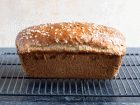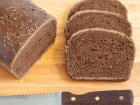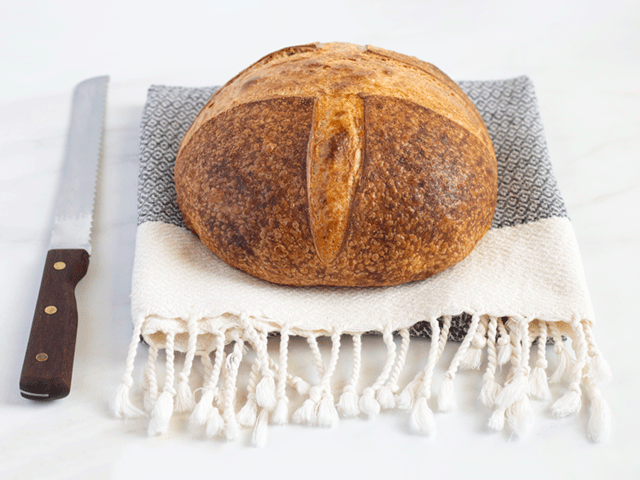
In a rush? You can skip straight to Naturally Leavened Cold-Proof Artisan White Sourdough Bread Recipe at my tumblr. Or you can jump to my Just the Basics section.
I lurk a lot on Reddit, specifically the Breadit subreddit. Although I don’t post a lot of content (at least not yet anyway), I like to see what other bakers are doing with their bread and what techniques work best for different people.
Something that caught my eye recently was blistered crust.
Seriously, the blisters are almost pornographic whenever someone shares their latest bake. The photos make me drool, and I get the itch to mix some flour, starter, salt, and water together.
With many of my recipes, however, blistered crust was a happy accident and not a consistent feature. Many Reddit users recommended a long, cold proof to achieve a blistered crust, but no one seemed to agree just how long of a proof one needed to get the best results.
So this week I set out to achieve the ultimate blistered crust with a simple, straightforward artisan loaf with white bread flour. I think I nailed it.
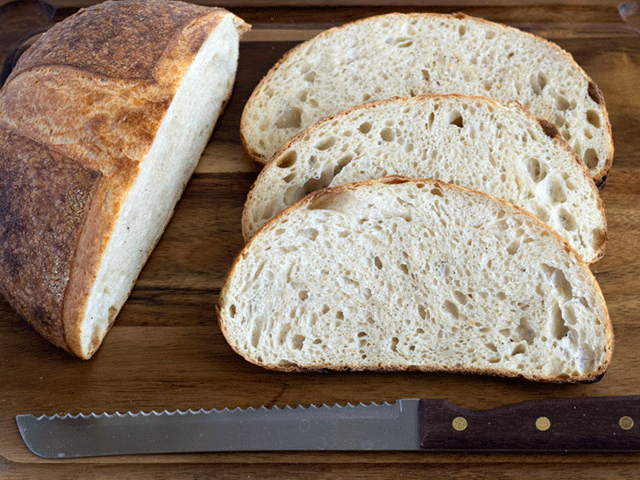
I Perfected the Timing for You
When I originally tried making this recipe, I tried to be smart about timing my proof. I used the equation I had found regarding yeast activity from my Summer Baking Tips, and I assumed that if I followed the rise times for my White, Wheat, and Rye Sourdough recipe that I would have a good estimate for how long I should refrigerate my loaf.
But alas, my first loaf fell flat. I forgot to consider the fact that my starter is not nearly as effective as commercial yeast and that 25% starter won’t be as effective as 100% starter. In the end, I had to keep pushing my fermentation time further and further until I got that beautiful oven spring and drool-worthy blisters that I wanted.
And now that I’ve done the legwork, you can enjoy the benefits. If you follow my recipe for naturally leavened cold-proof artisan white sourdough bread, you, too, can have amazing bread worthy of sharing on social media.
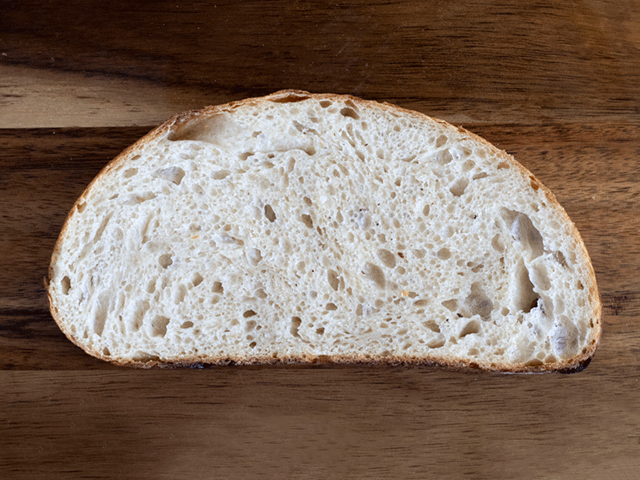
As you follow my recipe for my naturally leavened cold-proof artisan white sourdough bread, keep in mind that temperatures affect the timing for this loaf. If your kitchen or your refrigerator is hotter or colder than mine, you will need to adjust your fermentation period accordingly.
Fortunately, with a cold proof loaf, most of that fermentation time will happen inside your fridge where you’ll have a much easier time maintaining a consistent temperature. No need to worry about your kitchen getting hotter or colder as the day goes on.
Once you get the hang of this recipe, you can enjoy that blistered crust any time you want!
Time
Prep time: 30 to 40 Minutes
Rise time: 30 Hours
Cook time: 45 Minutes
Total time: 4+ Days
Ingredients
My Cold-Proof Artisan White Sourdough Bread doesn’t need a lot of fancy ingredients: just flour, water, and salt. My current sourdough starter is fed equal parts whole wheat flour and water (1:1 ratio by weight not by volume), so I make my levain using a little more whole wheat flour. However, this recipe should work just fine with strong bread flour.
Levain
- 6 Grams (3/4 Teaspoon) Sourdough Starter
- 50 Grams (1/4 Cup + 2 Tablespoons) Whole Wheat Flour or Bread Flour
- 60 Grams (1/4 Cup) Water
Bread Dough
- 500 Grams (4 Cups + 2 1/2 Tablespoons) Bread Flour*
- 400 Grams (1 2/3 Cup and 1/2 Tablespoon) Water
- 12 Grams (2 Teaspoons) Fine Sea Salt
*Don’t have bread flour? Neither do I. I typically combine all-purpose flour with vital wheat gluten to increase the protein content. Here’s my substitute:
- 472 Grams (3 3/4 Cups and 2 Tablespoons and ) All-Purpose Flour
- 28 Grams (3 Tablespoons and 1 Teaspoon) Vital Wheat Gluten
Vital Wheat Gluten is readily available at stores like Smith’s and Walmart. However, if you can’t find it in-store, you can buy vital wheat gluten online at Amazon for about $19 a bag.
Keep in mind that any time you purchase from an affiliate link like the one above, you support me as an Amazon associate. My opinions are my own, however, and I only share links to products I enjoy and use regularly.
Want to Scale the Recipe?
Is this recipe too big or too small? Here’s are the baker’s percentages so you can scale up or down as needed:
- 80% Hydration
- 25% Levain
- 2% Salt
Feel free to adjust the hydration if you feel it’s too high (or not high enough) for you. High hydration doughs can be difficult to work with, so don’t feel obligated to add as much water. Keep in mind that you’ll need to adjust your fermentation times to compensate.
Additional Equipment
If you want to make my naturally leavened cold-proof artisan white sourdough loaf with a blistered crust, you’ll need to have a few tools available:
- Kitchen Scale
- Container With Lid
- Bench Scraper/ Dough Cutter
- Banneton Basket
- High-Heat Parchment Paper
- Bread Lame
- Dutch Oven
- Wire Cooling Rack
- High-Heat Oven Mitts
These are just suggestions, however. As an Amazon Associate, I do get a small commission if you click on a recommended product. You don’t have to have these items exactly – they’re just what I like to use in my kitchen.
If you don’t have some of the above equipment, you can make a few substitutions. For example, I provided volume measurements so you can use measuring cups and spoons rather than a kitchen scale. If you don’t have a bench scraper, you can use a sharp knife and your hands to shape the dough. A mixing bowl lined with a linen towel could also function as a banneton basket while a razor could work for a bread lame.
Instructions
I like to make my Cold-Proof Artisan White Sourdough Bread over a weekend, when I have a lot more free time. However, this bread does take a few days and sometimes it spills over onto a Monday when I have to take my daughter to school, so my schedule reflects that.
Remember that you don’t have to follow this schedule exactly if you have a different routine than mine. Feel free to push the timing back further or start it earlier if it works better for you.
Day 1 – Feed Your Starter and Make the Levain
I only feed my sourdough starter once a day, and I don’t discard daily like some professionals recommend. Because of that, my starter is a bit sluggish. To ensure a nice, bubbly starter that’s strong enough to lift Cold-Proof Artisan White Sourdough Bread, I feed my starter in the morning and then create a levain the night before I make my dough.
10:30 AM – Feed Your Starter
I feed my starter a 1:1 ratio of flour and water. To get things moving, feed your starter 40 grams (1/4 cup) of each. Currently, my starter uses whole wheat flour that I grind myself, but you can use all-purpose flour if that’s what you have available.
10:30 PM – Make the Levain
Hopefully your early morning feed has your starter nice and bubbly by now. If not, that’s okay – the levain is your starter’s second chance to get active.
To make the levain, combine 6 grams (3/4 teaspoon) of your starter with 50 grams flours and 60 grams water (about 1/4 cup of each). Stir together until thoroughly combined.
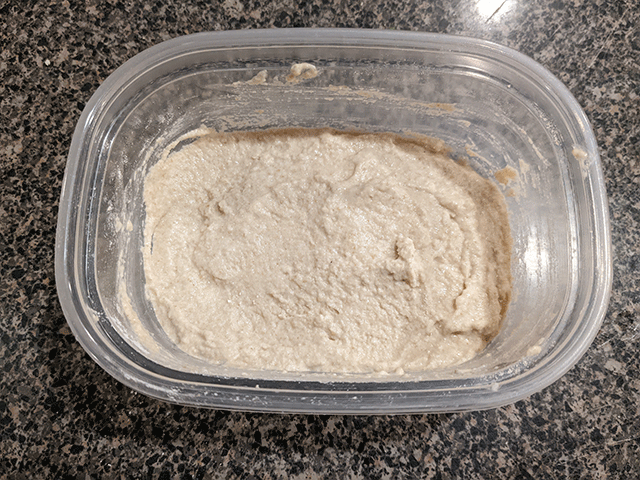
Cover your levain and let sit at room temperature (about 68 to 70 degrees Fahrenheit or 20 degrees Celsius) over night.
Day 2 – Autolyse, Mix, Fold, and Ferment
Today’s the day you work you dough, and it will be the most involved portion of making Cold-Proof Artisan White Sourdough Bread. Don’t worry – most of the work happens when you let it sit.
9:30 AM – Autolyse the Flour
First thing in the morning, you’ll want to autolyse your flour for 30 minutes to an hour (so feel free to start at 9:00 if that’s easier for you). The autolysation process allows your flour to soak up the water and soften some of the bran.
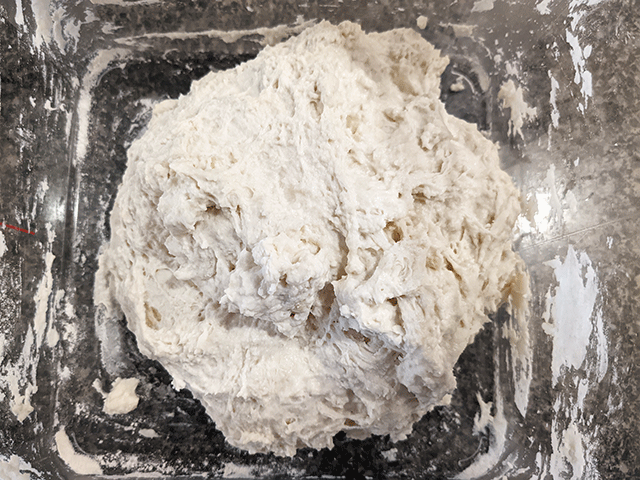
Combine 500 grams flour (about 4 cups) with 400 grams water (1 2/3 cup) and mix until a shaggy dough forms. Don’t worry about stretching and folding or shaping just yet. You don’t need to develop the gluten until later.
10:00 AM – Mix in the Levain
Ready to mix?
Dump your levain onto the dough. Wet your hands slightly with water and work the levain into the dough by stretching and folding the dough around the levain until thoroughly incorporated. It will be messy and sticky – and that’s okay!
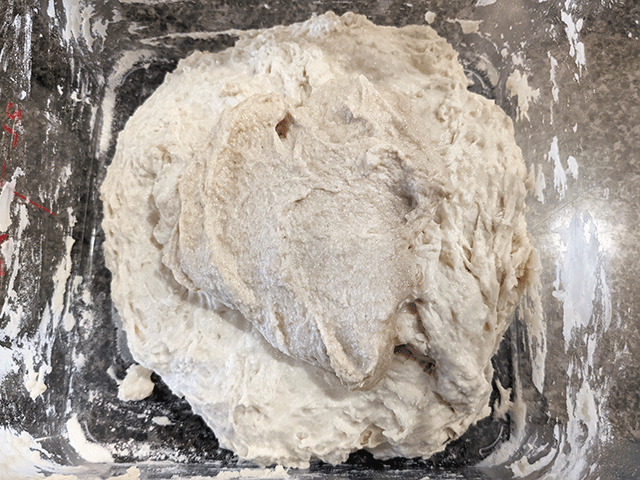
You still don’t need to knead or shape or make your dough look pretty. You just want to give the levain a chance to get active and working before you sprinkle in the salt.
Cover and let rest for 30 minutes.
10:30 AM – Mix in the Salt
It’s time to add your last ingredient: salt. Just sprinkle the salt over the top of the dough. As with the levain, you’ll want to wet your hands slightly. The water will help dissolve the salt and minimize the amount of dough that sticks to your hands.
Folding, squish, and work the dough until the salt has been fully incorporated.
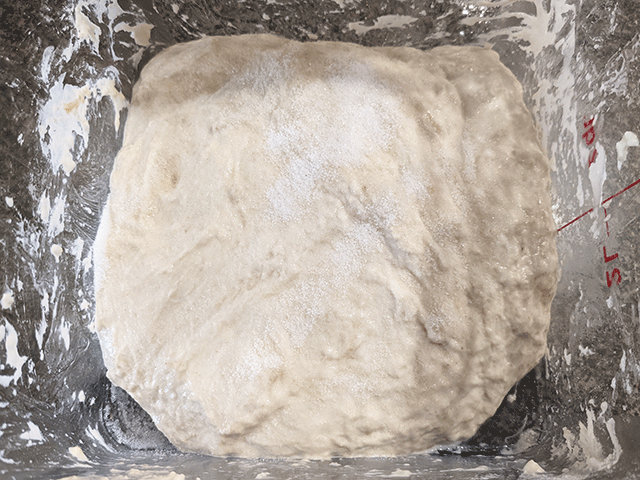
After you’ve mixed everything, cover and let your dough rest for another 30 minutes.
11:00 AM – 12:30 PM – Stretch and Fold the Dough
High hydration artisan bread can seem difficult to work with at first if you’ve only ever worked with low hydration yeasted bread. With so much water in the recipe, the dough will look like a goopy mess, and it won’t respond to traditional kneading.
To build up gluten and strengthen your dough, you’ll need to stretch and fold the dough over itself in multiple sessions. Start by grabbing a corner of your dough and pulling it up toward yourself. You want to lift until you feel some resistance but stop before you tear your dough.

Then fold the dough over the top of the rest. This first fold will look a bit like a taco.

Then repeat – grab a corner, stretch it up toward you, and then fold. Keep going until you’ve grabbed all the “corners” and your dough has formed a round.
Let your dough rest for 30 minutes.
After resting, your dough will have relaxed quite a bit. It won’t look much like a round anymore. But don’t worry. Your dough will start to take shape and smooth out after a bit more work.
For this recipe, you’ll need to perform a total of 4 stretch and fold sessions over the course of 2 hours with 30 minute breaks in between each session. Don’t worry if your schedule doesn’t allow for perfect timing – it’s fine if you need to let your dough rest a little bit longer between sessions if you’re busy. Just remember that you want to give your dough plenty of time to ferment uninterrupted later.
12:30 PM – 9:00 PM the Next Day – Bulk Fermentation
This is my favorite step of the entire Cold-Proof Artisan White Sourdough Bread baking process – just letting the dough sit!
After you’ve finished all your stretch an folds, let your dough sit covered at room temperature for two hours to give your yeast a chance to work.
If you’re following my example schedule, your dough will sit from 12:30 to 2:30 PM. Keep in mind that my ambient kitchen temperature ranged from 68 degrees to 70 degrees Fahrenheit (20 degrees Celsius). I made this recipe in the winter, so my kitchen was naturally colder, which is perfect for a long, cold proof.
If you are making Cold-Proof Artisan White Sourdough Bread during the summer or in a warmer kitchen, you may want to cut the time on your counter to just an hour or even 45 minutes.
After letting your dough sit at room temperature, put it in the refrigerator for a long cold proof: about 31 hours and 30 minutes. Again, you should note that my refrigerator keeps the dough at steady 45 degrees Fahrenheit (7 degrees Celsius). If your fridge is colder, your dough may need to proof even longer in the fridge.
A Little Note
Yes, I know the ideal refrigerator temperature should be set to 37 degrees Fahrenheit (2 degrees Celsius). However, my fridge is a bit finicky and foods in the back will freeze over when I set it lower. I used a thermometer to test my dough and my fridge. My fridge measured 40 degrees while the dough measured 45 degrees when I took it out. I’m not entirely sure why the two thermometers measured differently.
Day 3 – Shape and Retard
Day 3 of this Cold-Proof Artisan White Sourdough Bread recipe only requires a few minutes of your time, but they are critical minutes. How you pre-shape and shape the dough will determine whether your loaf turns out dense or fluffy, lumpy or lovely.
Shaping does take some practice, and even after hundreds of loaves, I still don’t feel comfortable with the shaping process. However, you don’t have to be perfect – your bread will still taste incredible even if it looks less like a batard or a boule and more like a blob. Hopefully, my step-by-step process with pictures will make things easier for you.
9:30 PM – Bring Dough to Room Temperature
Cold dough resists stretching and movement, making it difficult to shape. So it’s easier to work with, I prefer to bring my dough to room temperature. Pull your container out of the fridge and let it sit for an hour.
10:30 PM – Pre-Shape the Dough
Turn your dough out onto a clean surface – no need to flour or grease your kitchen counter. Any extra flour during this stage will not mix well into your dough, and you’ll end up with flour pockets in your baked loaf.
Start by sliding your dough cutter or bench scraper under your dough.

Then gently turn your bench scraper like a steering wheel. As you turn, gently push your scraper into the dough to create some tension. Don’t push so hard that you break the dough skin.
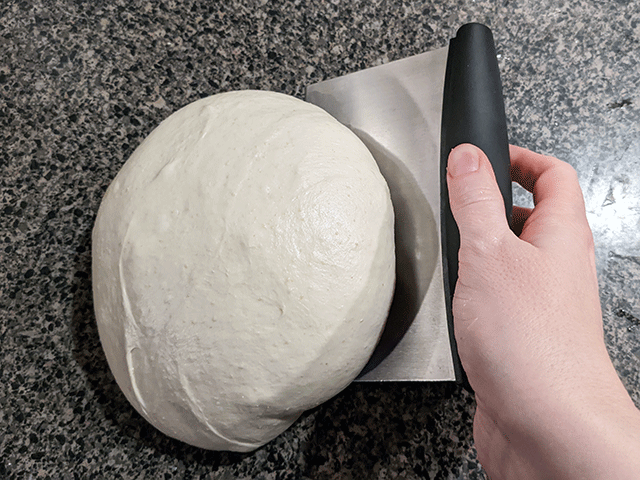
Repeat sliding, turning, and pushing around the edges of your dough. Once you’ve gone around the entire outside edge of the dough, you should have a nice, smooth round of dough.
Cover your dough and let it rest for about 15 to 20 minutes. I like to simply overturn my dough container and use that to keep the dough from drying out. Don’t worry about your dough losing its shape – it will relax during this waiting period, and you will shape it again in a bit.
10:45 AM – Shape the Dough
I have two methods for shaping Cold-Proof Artisan White Sourdough Bread. I, personally, find boules easier to shape than batards. But they both have their advantages and disadvantages. Feel free to try either technique when shaping your dough.
To Make a Boule (Round Loaf)
I’ve found the easiest way to make a boule is to repeat the pre-shaping technique. Simply start by sliding your bench scraper or dough cutter under one side.

Then rotate and push into your dough. Again, don’t push so hard that you break the dough skin, but feel free to work the dough enough to build some tension.

Repeat your sliding, turning, and pushing technique all the way around the dough until you have a smooth dough round.
When you’ve finished, slide your bench scraper under the dough and then flip the round into a flour-lined Banneton basket. The shaping seams will face up toward you (so they don’t interfere with your scoring patterns later).
If your dough lacks tension, you can stitch the sides together for a tighter round. Wet your fingers and grab the edges of your dough and pull them toward the middle, alternating sides for even tension.
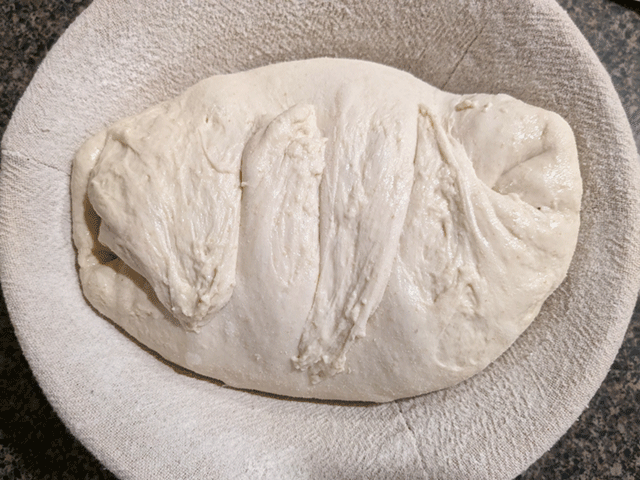
You should note that this stitching technique works better with batards (long loaves) than with boules (round loaves), but it can help build tension with slack dough.

Once you’ve stitched the middle, fold over the edges and pinch it to create a rounder loaf. I know my stitching isn’t perfect in this picture, but it doesn’t need to be. The dough will relax somewhat in the fridge after shaping.
To Shape a Batard (Oval Loaf)
A batard has a few extra shaping steps than a boule – but if you have quick, steady hands, you might enjoy the end results a little more. I find batards are much easier to score than boules, and they make for better sandwiches, as the pieces tend to be more even throughout the loaf.
To start, stretch your dough out into a rectangle.

Next, fold in about one third of one side of the dough.
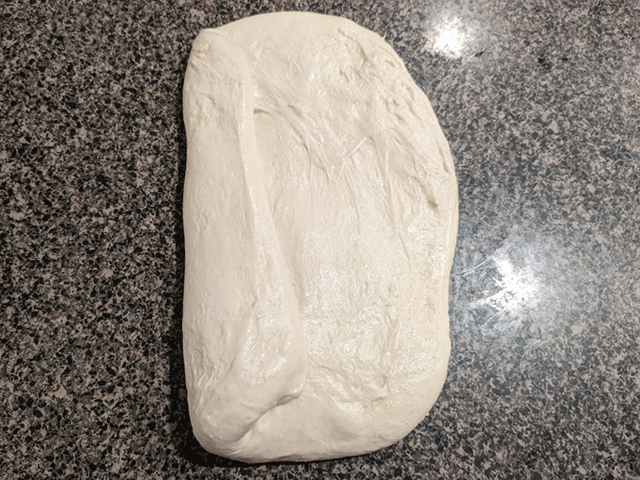
Next, you grab the opposite side and fold it toward the middle as well. I know this picture doesn’t demonstrate it as well as it could (the dough kept trying to relax whenever I grabbed my camera). But you want to leave one end wider than the other.
For a better tutorial on batard shaping, be sure to check out my 50/50 Wheat and Rye artisan style bread. It has a stiffer dough that’s more pliant, so it was easier to snap photos of my process.
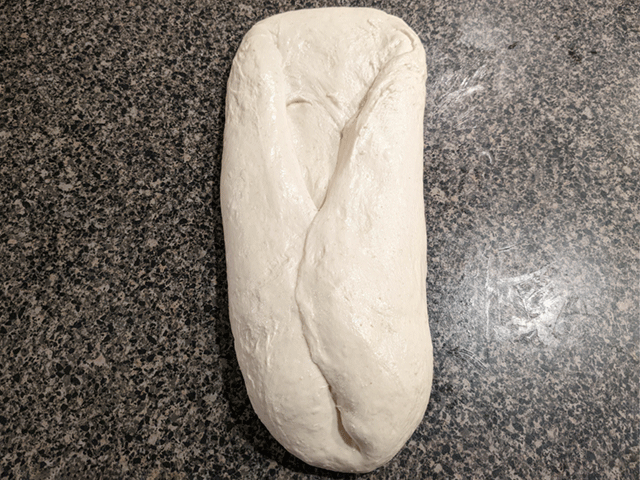
Starting with the narrow end of your dough, roll it toward the wider end of your dough. Try to roll the dough tight enough that it doesn’t create unnecessary air pockets, but don’t roll it so tight that you break the skin of the dough. In the picture below, I rolled it a little too tight and you can see the small circular split in my shaping.
For best results during shaping, use steady, confident movements. If you go too slow, the dough will stick to itself and try to snap back to its original shape. If you go too fast, you’ll end up with a lop-sided loaf like the one below.

If you rolled your batard correctly, you should have enough dough slack to pinch the ends together and create a tight seal. If your dough is a bit stubborn, you can use a tiny bit of rice flour to give it some grip.
Use your bench scraper to flip the dough into your floured banneton so the seams of your shaping face up toward you. In this picture, my dough did not want to stay rolled, and it started to unwind as soon as I grabbed my camera. In instances like this one, you can use a little bit of rice flour and stitch the edges together to rebuild the tension.
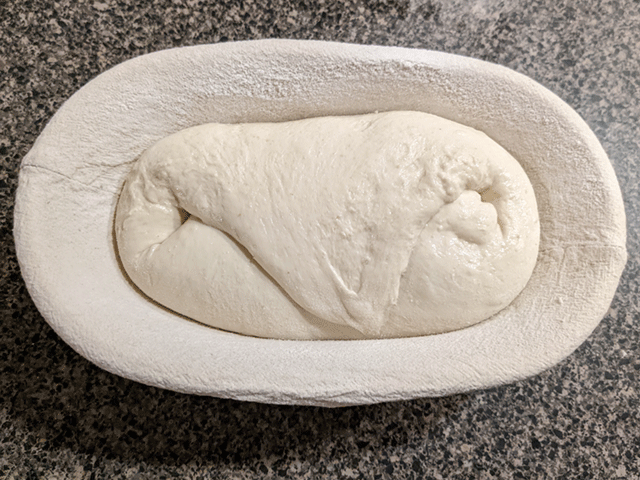
It’s okay if your dough isn’t perfect – it will relax in the fridge. The goal here is just to create a bit more tension for a nicer oven spring.
10:45 PM – Retard the Dough in the Fridge
Once you’ve stitched up your dough, go ahead and cover it and put it back in the refrigerator to sit over night.
Day 4 – Bake
Your long awaited Cold-Proof Artisan White Sourdough Bread has almost finished! Just a bit longer, and you’ll soon have a dreamy sourdough loaf.
If you were to take a peek at your dough, you’d see that it has relaxed in the fridge. The stitching that you worked hard on the previous night will have likely sunk into the rest of the dough for the most part.
But don’t put it in the oven just yet! You have a few tiny steps left to do.
9:30 AM – Preheat the Oven and Dutch Oven
Before you get baking, however, you’ll need to preheat your Dutch oven inside your oven to 500 degrees Fahrenheit (260 degrees Celsius) for at least 45 minutes to an hour to ensure your Dutch oven has fully heated.
Don’t bake directly on a cold Dutch oven – or your dough will stick and make a big mess.
10:25 AM – Score the Dough
Once your oven has thoroughly heated, you need to prep your dough for scoring. Turn it out onto high-heat parchment paper. Do not use cheap regular parchment paper, or the paper will burn (and potentially catch fire) in your oven.
It’s okay if your dough spreads out a little bit once on the parchment. Just brush off any excess flour on the top and grab your bread lame.
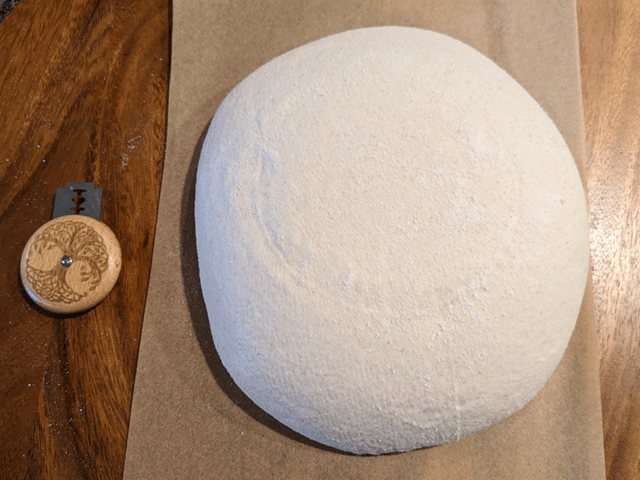
A proper score not only improves the appearance of your bread, but it promotes better oven spring by releasing steam. Your loaf will need at least one deep slash for best results.
For this loaf, I stuck to a cross shape that stretched across the entire loaf. That way the entire loaf could open properly, but I didn’t have to worry about cluttering the bread with too many smaller cuts.
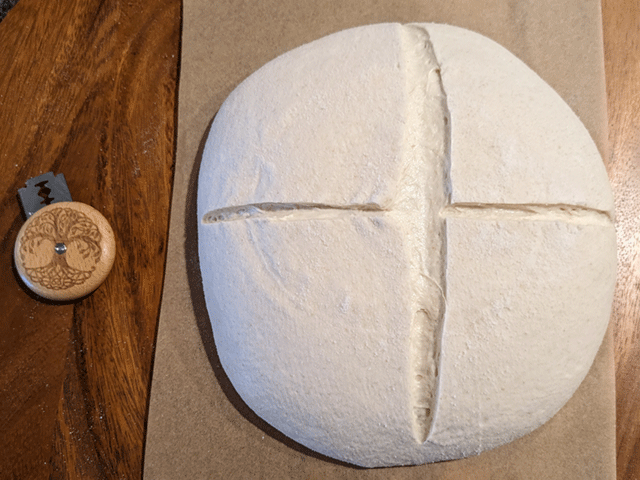
Keep in mind that this high hydration loaf will be at the end of its strength, and the gluten has started breaking down at this point. Your Cold-Proof Artisan White Sourdough Bread will have enough to hold itself together during baking, but it will be a difficult loaf to score. I recommend keeping your scoring simple, and don’t worry too much about going for an ear.
10:30 AM – Bake and Cool
Got your bread scored? Your oven heated? It’s time to bake!
Use your transfer your parchment paper and dough to the Dutch oven, and place an ice cube under the parchment paper. Quickly cover with a lid to capture the steam from the melting ice cube. Then, place your Dutch oven in your oven and bake covered for 45 minutes.
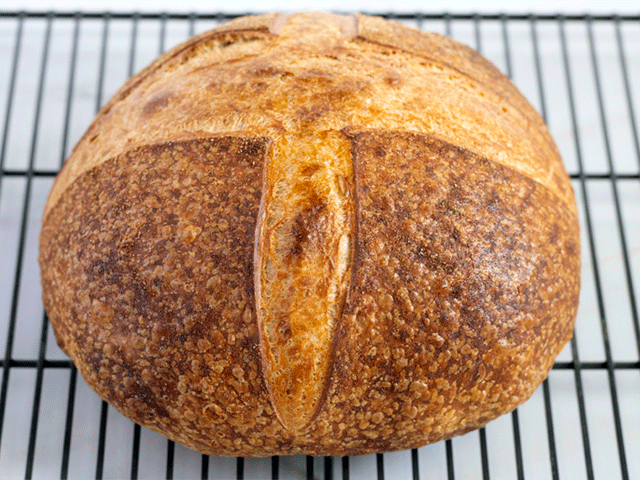
When it’s finished, transfer the loaf to a wire cooling rack and allow it to cool completely before cutting into it. As delicious as your bread looks right now, keep in mind that it continues to bake with its own residual heat. If you cut into your loaf prematurely, the crumb may become gummy and sticky rather than soft and chewy.
And you’re done! Feel free to slice, serve, and enjoy your Cold-Proof Artisan White Sourdough Bread. When properly stored at room temperature, your loaf should stay fresh for 5 days (assuming you don’t eat it faster than that!). Avoid storing your bread in the fridge, as it will go stale faster and will only last about 2 to 3 days at most.
Just the Basics

Naturally-Leavened Cold-Proof Artisan White Sourdough Bread
Ingredients
Levain
- 6 Grams Sourdough Starter – Fed, Active, and Bubbly (3/4 Teaspoon)
- 50 Grams Whole Wheat or Bread Flour (1/4 Cup + 2 Tablespoons)
- 60 Grams Water (1/4 Cup)
Bread Dough
- 500 Grams Bread Flour* (4 Cups+ 2 1/2 Tablespoons)
- 400 Grams Water (1 2/3 Cup + 1/2 Tablespoons)
- 12 Grams Fine Sea Salt (2 Teaspoons)
*Alternative to Bread Flour
- 472 Grams All-Purpose Flour (3 3/4 Cups and 2 Tablespoons
- 28 Grams Vital Wheat Gluten (3 Tablespoons and 1 Teaspoon)
Instructions
Day 1
- 10:30 AM – Feed your starter 40 grams whole wheat flour and 40 grams water.
- 10:30 PM – Make the levain by combining 6 grams (3/4 teaspoon) of your starter with 50 grams flours and 60 grams water (about 1/4 cup of each).
Day 2
- 9:30 AM – Autolyse the flour by combining 500 grams flour with 400 grams water. Mix until a shaggy dough forms. Let rest for 30 minutes.
- 10:00 AM – Mix in the levain into the flour mixture. Let rest for 30 minutes.
- 10:30 AM – Mix the 12 grams of salt into the dough. Let rest for 30 minutes.
- 11:00 AM – 12:30 PM – Stretch and fold the dough 4 times with 30 minute breaks between each session.
- 12:30 PM – 2:30 PM – Bulk fermentation at room temperature in a covered container.
- 2:30 PM – Midnight – Transfer container to refrigerator and continue bulk fermentation.
Day 3
- 12:01 AM – 9:00 PM – Continue bulk fermentation in the fridge.
- 9:30 PM – 10:30 PM Remove dough container from the fridge and let sit on the counter at room temperature.
- 10:30 PM – Pre-shape the dough. Cover with the container and let rest for 15 to 20 minutes.
- 10:45 PM – Final shape the dough. Transfer to a Banneton basket, cover, and place in the fridge over night.
Day 4
- 9:30 AM – Preheat the Dutch oven inside the oven at 500° Fahrenheit (260° Celsius) for 45 minutes to 1 hour.
- 10:25 AM – Remove the dough from the fridge. Transfer to high-heat parchment paper, and score with a lame.
- 10:30 AM – Transfer the dough to the Dutch oven. Place an ice cube inside and add lid. Bake for 45 minutes covered.
- 11:15 AM – Place bread on a cooling rack and let cool completely before slicing and serving.
Secrets to Success
Many bakers know that a long, cold proof is the secret to developing sourdough flavor. However, if your bread ferments for too long, the flour will start to break down, and it won’t be able to effectively trap and hold the gasses that give your bread lift. As a result, the hardest part about Cold-Proof Artisan White Sourdough Bread is striking the delicate balance between over proofed and under proofed.

I did my best to take a lot of guesswork out of my recipe by providing example times and temperatures. However, your kitchen and oven temperatures will be unique to your home, so you’ll likely have to make a few tweaks to get this recipe just right.
Signs Your Bread Is Under Proofed
If you’re just starting out with baking, you might have trouble pinpointing where your loaf went wrong. However, most beginning bakers tend to under proof their loaves rather than over proof. If your bread has the following problems, it likely needs more time rising:
- Large, tunneling holes
- Irregular, uneven distribution of holes
- Little to no oven spring
- Dense, gummy, spongey crumb
To fix this problem, push the fermentation time by about 30 minutes each time you bake until your loaf starts to look over proofed (and then pull it back again – a fully proofed loaf is just on the border of being over proofed).
Signs Your Bread is Over Proofed
Cold-Proof Artisan White Sourdough Bread includes a lot of fermentation time, so it is easy to let your dough sit too long (either on the counter or in the fridge). If your loaf has the following problems, it might need a little less time in the fridge before baking:
- Ragged edged holes rather than round ones
- Slack, irregularly shaped loaf
- A thin crust that separates from the rest of the loaf
To fix this problem, pull back the fermentation time by about 30 minutes each time you bake until your loaf has an even distribution of holes and a tall oven spring.
A Note About Timing
If you’re more experienced at reading crumb and understanding artisan bread, then you’d be able to tell that the pictured artisan bread is slightly over proofed, and I’ll explain why.
When I set about making Cold-Proof Artisan White Sourdough Bread, I had certain time restraints to work into my schedule. I had to figure out how to make this bread while juggling my daughter’s school schedule and without eating too much into my usual sleeping routine. As a result, I couldn’t let the bread ferment too late into the night or do my stretch and folds too early in the morning.
I did my best to strike the right balance, but in the end I felt that this slightly over proofed loaf had a better crumb and texture overall than the loaves that proofed for less time. If you really want that ear that comes with a perfectly proofed loaf, feel free to tweak it further if your schedule allows. You might need to start your bread earlier and let it refrigerate longer without time spent at room temperature. Or you might just want to bake your bread earlier so it doesn’t retard as long. It’s up to you. Take notes and see what works.
Feel free to leave me additional tips and feedback in the comments below. Your expertise is invaluable and can help me improve my recipe.
Nutritional Information
This naturally leavened Cold-Proof Artisan White Sourdough Bread only uses water, flour, salt, and starter as its key ingredients. If you’re curious about its nutritional information, here’s a quick peek at what’s inside:

Keep in mind that I cut my loaf into 10 slices, and since this is a round loaf, the nutritional information reflects an average of the slices rather than each individual slice (the ends of the bread being smaller than the middles). If you cut your bread into thicker or thinner slices, the calories per serving will vary.
Did You Try It?
I worked hard to get this recipe just right – and I love it when my friends and family try my latest recipes. However, I also acknowledge that I’m not a professional, and there’s definitely room for improvement with every loaf I make. If you have honest suggestions and feedback, feel free to contribute to the comment section below. And, don’t forget to leave a star rating if you enjoyed my Cold-Proof Artisan White Sourdough Bread! Your engagement helps keep my site running, thank you.


